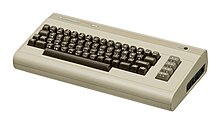Enter key
This article needs additional citations for verification. (January 2008) |

In computer keyboards, the enter key (or the return key on Macs[1] and most Sun Workstations[2]) in most cases causes a command line, window form, or dialog box to operate its default function. This is typically to finish an "entry" and begin the desired process, and is usually an alternative to pressing an OK button.
The return key is often also referred to as that by many American groups (and even marked as) the enter key and it usually performs the same function as the enter key, but in some applications (mainly page layout, word processing and in typewriting) it is the one that operates like the carriage return key from which it originates. It typically has an arrow pointing down and left (↵), which is the symbol for carriage return.
The enter key is typically located on the lower right of the numeric keyboard, and the return key (often marked as the enter key) on the right edge of the keyboard, under backspace in older computers and under the vertical bar key in most newer machines (assuming a standard US layout).
Apple commonly uses the symbol ⌤ (U+2324, "UP ARROWHEAD BETWEEN TWO HORIZONTAL BARS") to represent the Enter key.[3]
Differences between Enter and Return

On some keyboard layouts, the return and enter key are two different keys, an artifact of the differing handling of newlines by different operating systems. As an example, on the Macintosh, the return key is the usual key, while the enter key is positioned at the lower right of the numeric key pad. For example, while using the text tool in Adobe Photoshop, the return key produces a new line while the enter key ends editing mode.
On IBM's 3270 and 5250 line of terminals, the Enter key was located to the right of the space bar, and was used to send the contents of the terminal's buffer to the host computer. The Return key was located in a more standard location, and was used to generate a new line.
Apple also took advantage of this situation to create a highly editable command line environment called a "Worksheet" in the Macintosh Programmer's Workshop, where return was used strictly as a formatting key while enter was used to execute a shell command or series of commands in direct mode.
In technical terms, the Macintosh keyboard maps the return key to a carriage return, while the enter key maps to a newline.
Historically, many computer models did not have a separate keypad, and only had one button to function as Enter or Return. For example, the Commodore 64 (manufactured from 1982) had only the "Return" key.
Uses
In pocket calculator-like programs (for example, Microsoft Calculator for Windows users), the enter key of the numeric keypad acts like the equal to (=) button to obtain the result of the previously entered operations.

Usually the default button on a form is highlighted, giving a subtle visual clue that the user has the option of clicking the button or simply pressing Enter.
In modern word processing applications, pressing the return key ends a paragraph and starts a new one. Spacing between the paragraphs can be defined through paragraph styles.
In old times when Typewriters were used the "Enter" was kept big, the reason behind it was that when a typist type something the most frequent alphabet is "SPACE" so space-bar is large, the same reason is in "ENTER" key, this button is being press with high frequency, so a large size reduce finger slip chances.
